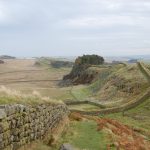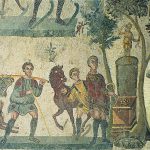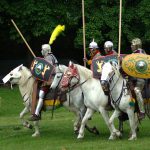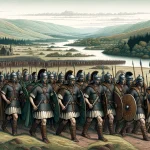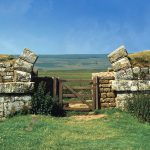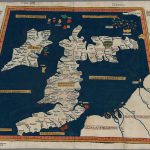Rochester (Durobrivae)
Minor Settlement
Prior to the Roman occupation, the same site was occupied by the second largest oppidum in the canton, and was in all likelyhood the centre of administration for the western half of the iron-age kingdom of Cantion, even before the Romans officially made it the administrative centre of the second pagus in the civitas of the Cantiaci.
The name Durobrivae means ‘the walled town of bridges’, implying the possibility of there being several bridges over the river Medway in either the Roman or iron-age periods. In 1850, the location of at least one Roman bridge was suggested by tentative evidence lying just north of the later medieval bridge, and on the same line as the bridge contructed in 1856.
There is no evidence for the existence of any pre-Roman bridge at Rochester, though one at least is likely to have existed as the North Downs Way crosses the Medway in this vicinity.
The original road through Durobrivae was 2.8 m. wide, later widened into a dual-carriageway with a central drainage-channel 6.7 m. wide; this was not to last long however, as the south-western road soon became disused and was built over; notably by a second century bath-house complex.
The Romano-British town was first surrounded by a turf rampart in the latter half of the second century, which was rebuilt in stone in c.225AD, a good half century prior to Durovernon.
The question whether or not a temporary Roman fort was established at Rochester during the invasion period is not known, partly because the most likely site was later occupied by the Medieval castle.
There are no Latin inscriptions on stone recorded in the R.I.B. for Rochester, but a Roman milestone or honorific pillar has been uncovered at Shorne Warren, about three miles westwards along Watling Street.
The only significant Roman military remains found at Rochester are two swords found during dredging of the River Medway at Limehouse Reach to the east of the castle. This may mark the spot where the Batavian regiments under the command of Julius Civilis, numbering perhaps 4,000 cavalrymen, crossed the River in force, thereby breaking the stalemate between the invading Roman army and the opposing forces of the British warlord Togodumnus.
RIB 2219 - Milestone of Flavius Severus and Maximinus Daia
For our Lords Flavius Valerius Severus and Galerius Valerius Maximinus, most noble Caesars.
FLA VAL
SEVERO ET
GAL VAL M
AXIMIN
O NOB[...]L
[...]
A modern inscription, the warren | shorne, has been cut over lines 4, 5.Flavius Severus and Maximinus Daia were Caesars 1 May 305-25 July 306.
Classical References for Durobrivae (cantiacorvm)
The Roman name for Rochester appears in three (out of fifteen) itinera in the second century list of principal routes in the empire, the Antonine Itinerary. In Iter II, the route from Hadrian’s Wall to the port of Rutupiae (Richborough, Kent), the road-station Durobrivis is listed 9 miles from Vagniacis (Springhead, Kent) and 13 miles from Durolevum (Ospringe, Kent). In Iter III, the route from Londinium to Portus Dubris (Dover, Kent), Durobrivis appears 27 miles from London (Londinium) and 25 miles from Durovernum (Canterbury, Kent). Rochester also appears in Iter IV, the route from Londinium to Portus Lemanis (Lympne, Kent), recorded here with exactly the same details as in Iter III.
Rochester also appears in the seventh century Ravenna Cosmology, this time appearing as Durobrabis (R&C#74), between the entries for Richborough and the unknown station Landini.
Situated at the lowest bridgeable point of the river Medway, which here cuts through the chalk of the North Downs before flowing into the Thames Estuary, Durobriovae was one of only two walled towns in the territory of the Cantiaci, the other being the cantonal capital Durovernum Cantiacorum.
References for Dvrobrivae (cantiacorvm)
The Roman Inscriptions of Britain by R.G. Collingwood and R.P. Wright (Oxford 1965); The Roman Inscriptions of Britain by R.G. Collingwood and R.P. Wright (Oxford 1965); The Roman Inscriptions of Britain by R.G. Collingwood and R.P. Wright (Oxford 1965); The Roman Inscriptions of Britain by R.G. Collingwood and R.P. Wright (Oxford 1965);
Map References for Dvrobrivae (cantiacorvm)
NGRef: TQ742686 OSMap: LR178
Roman Roads near Dvrobrivae (cantiacorvm)
Watling Street: WNW (9) to Vagniacis Watling Street: ESE (17) to Dvrolevvm (Ospringe, Kent) S (5) to Eccles (Kent) Watling Street: ESE (17) to Ospringe
Sites near Rochester (Durobrivae)
- Battle of Medway (5 km)
- Eccles Claudian Villa (8 km)
Barrow, Roman-Building, Temple Or Shrine and Villa - Pilgrims' Way (10 km)
Roman Road - Maidstone (12 km)
Villa - Springhead (Vagniacis) Roman Town and Temple complex (13 km)
Minor Settlement and Temple Or Shrine - Horton Kirby (18 km)
Villa - Hadleigh Roman Signal Station (19 km)
Signal Station - Lullingstone Roman Villa (21 km)
Temple Or Shrine and Villa - Durolevum (Faversham?) (26 km)
- Ospringe (Durolevum?) (26 km)
Minor Settlement
